A little over a fortnight ago, during my yoga retreat, I spent a glorious half-hour swinging in a hammock. To the right of me were the rolling hills of Cádiz; to my left, some of the retreat group were sat together on sun loungers, laughing and joking. A few metres behind me, two others sat peacefully together on a wooden bench, admiring the view.
I was, as Nick Carraway says in The Great Gatsby, both ‘within and without’. Just close enough to tune into other people’s voices, just far enough to retreat into my own thoughts if I wished to. It was solitude without any fear of loneliness, because I could see – quite literally – the pathway to connection, just a few steps ahead of me.
And so I relaxed, gently rocking in the breeze. I lay back, scribbling into a brand-new yellow journal, supported not only by the stripy canvas material beneath me but by that feeling of connection, however passive, to others.
Alone, comfortably
It made me think of psychoanalyst Donald Winnicott, who wrote that learning to be alone is something that must first be developed in the presence of a caregiver. In an ideal world, a parent (or equivalent) will spend time ‘alone together’ with their child, present but not interacting:
‘Thus the basis of the capacity to be alone is a paradox; it is the experience of being alone while someone else is present.’
- The Capacity to be Alone - 1958
Eventually, theorised Winnicott, the child learns to ‘internalise’ the supportive presence: the caregiver figure becomes a soothing idea in their heads, even when not physically-present. Thus, they learn to be comfortably alone.
While I appreciate Winnicott was referring to childhood (as those in his profession so often do), there’s a question I’d like to ask the late psychoanalyst, were he a guest at my fantasy dinner party, and that question is: ‘Does this feeling of comfort have an expiry date?’. And – bonus question, in fact – ‘If you never learnt to be alone as a child, can you recreate such an experience in adulthood?’
There are times in my life where aloneness feels very comfortable. For instance, in the set-up I describe above, which reinforces a feeling of safe, unthreatening alonement. But that shifts and changes, depending on where I am – geographically, chronologically, emotionally.
Comfortable aloneness is much harder to come by in, say, university halls, where the too-thin walls imbue any solitude with a chronic FOMO, echoes of one’s peers talking or laughing or shagging at most hours. Granted, I have accrued some maturity since I was at university – that, and questionably better social skills. Yet, I think, thrown into the same circumstances, I would still feel a lot less settled there than I did in my hammock.
It has a lot to do with infrastructure.
Places to be alone, places to gather: The power of having both
Take this retreat centre. I asked my friends from the trip – an architect couple based in Milan – to produce the labelled diagram above, so that I could explain the layout, which is made up of:
Shadowed spaces: A shaded area with a couple of small tables, for eating or drinking in smaller groups.
Moroccan pergola: A covered area with comfy, upholstered low-seating and lots of throw cushions. Plus a low-table, i.e. for books or tea mugs.
Hammock: A place to swing solo!
Bench: A place to sit alone and enjoy the view, or to enjoy with one other person.
Sun beds and umbrellas: Outdoor furniture that could be arranged for more or less interaction, for instance pushed together, or pushed further back in the shade.
Connection space: A wider stretch of grass to gather and picnic on.
The OM Dome: Our main gathering space for yoga practice as a group.
Lotus Shala: Shala is a Sanskrit word meaning ‘home’. Suryalila had multiple shalas dotted around the wider site, intended for private yoga practice or silent meditation.

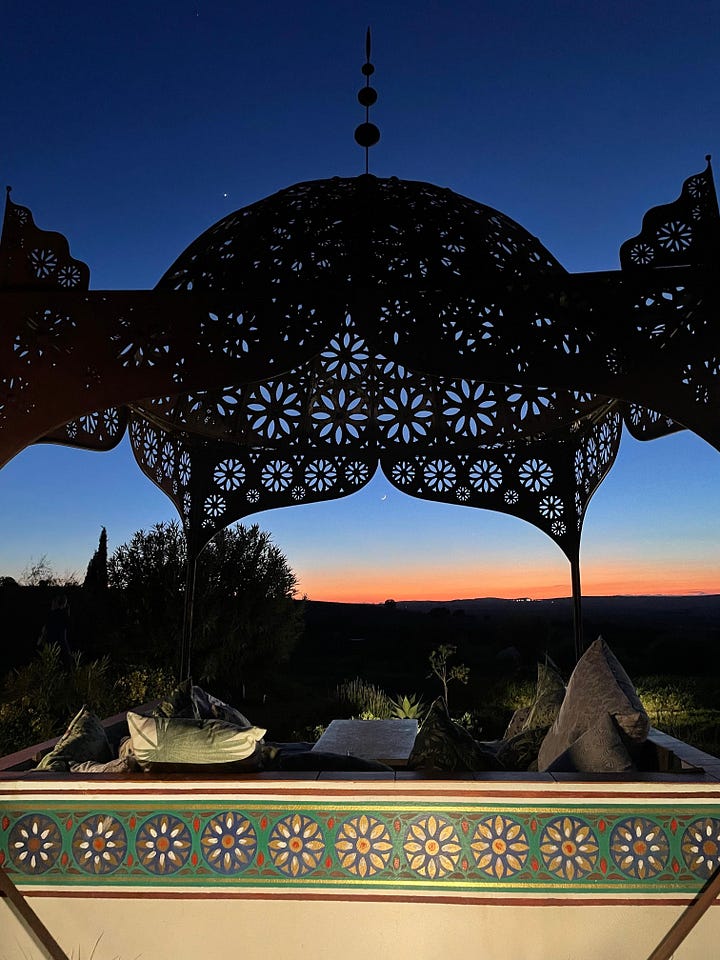
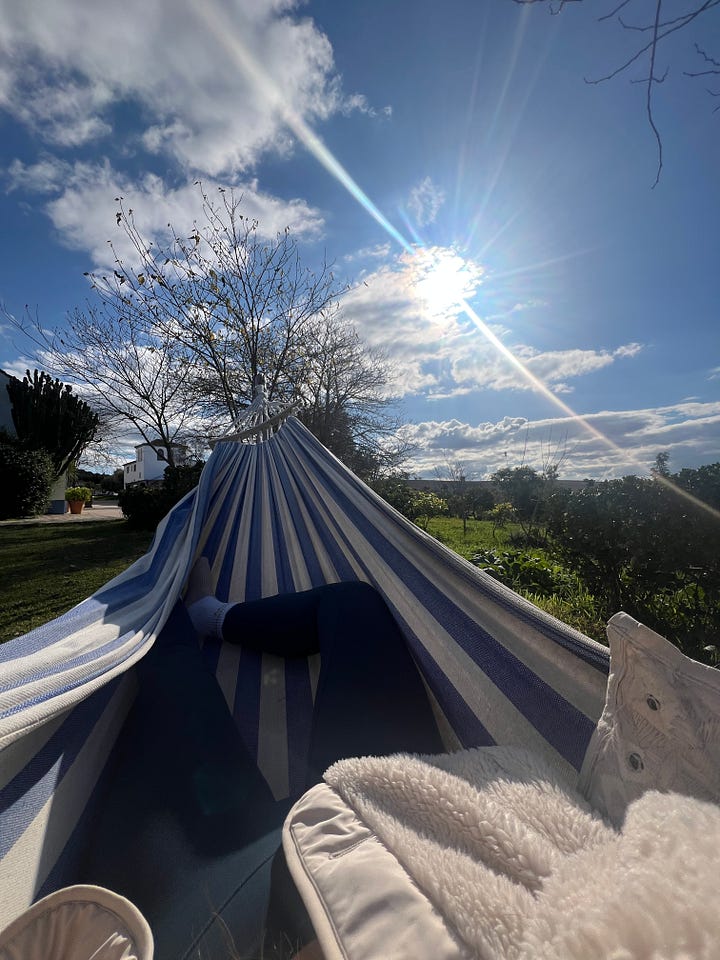
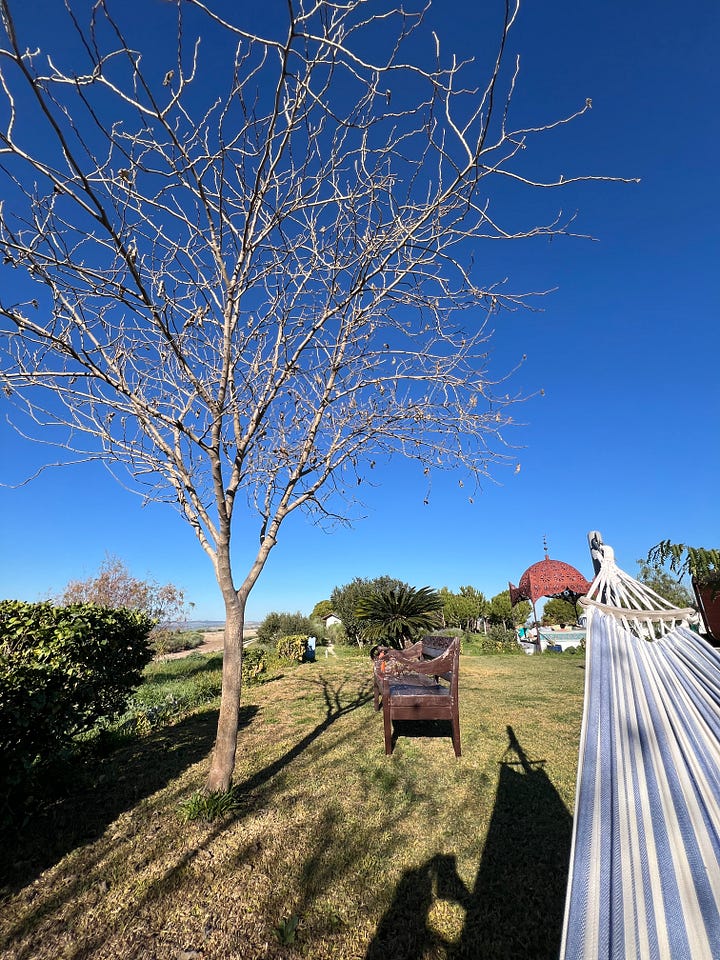
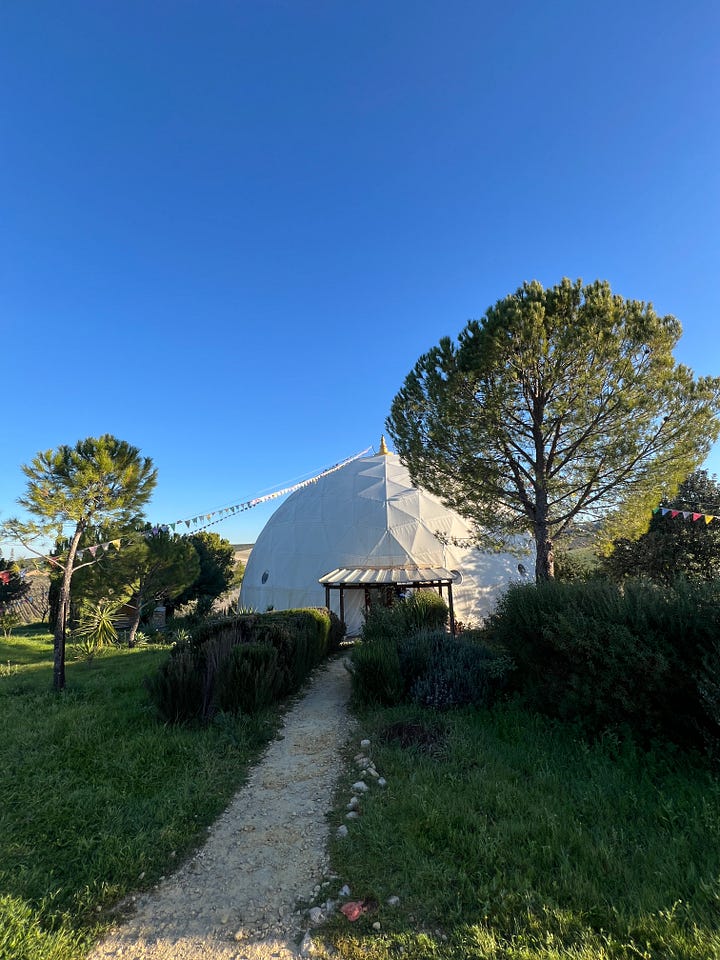
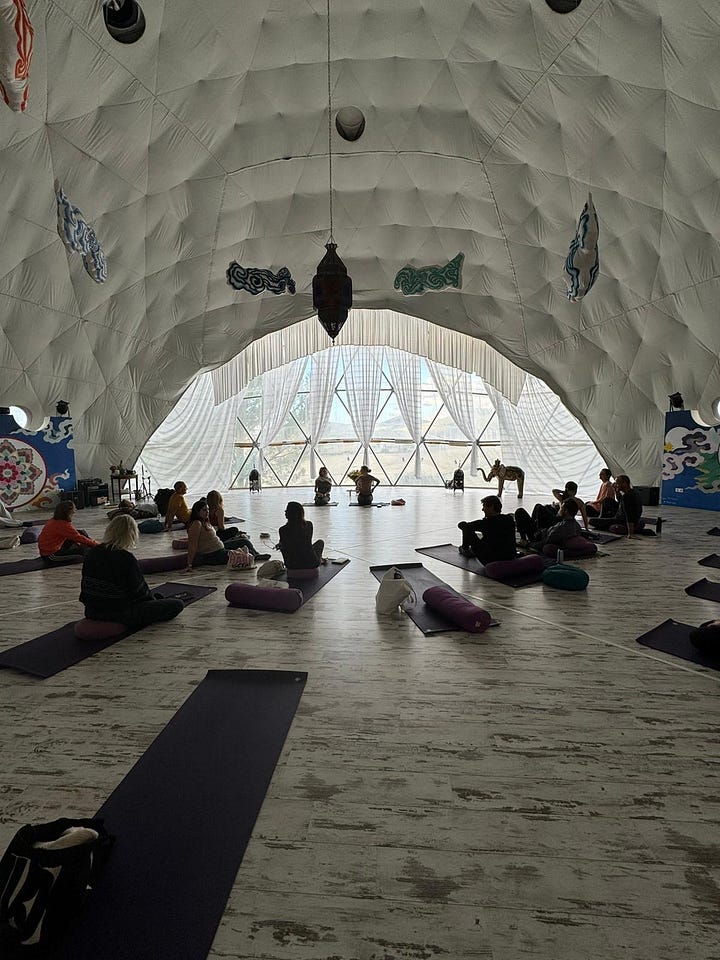
Choose your own adventure
The beauty of this set-up is the choice it offers.
With the exception of the Lotus shala – where silence is often necessary – the ‘solo’ spaces are placed amid the action, offering the opportunity for connection: for instance, if someone joins you on the bench.
Meanwhile, the bulk of the communal areas offer a ‘flexible’ approach to socialising, where you can choose to be the chattiest, Tigger-like extrovert there is, or else you can sit and read or journal together in near-silence, the way a married couple might do together in bed.
This was most true of the Moroccan pergola, pictured below. As a fellow retreat-goer described it:
‘People come and go, and it's easy to sit down because you don't feel you're invading. You sit with others, and choose if you want to talk, read, listen to music etc. Everything is possible, and nobody judges you for what you're doing. It's easy to start a conversation, even with strangers. We discussed serious topics such as cancer treatment but we also laughed a lot.’


When spaces shape our reality
You know the phrase, ‘if walls could talk’? To me, it’s misleading – because I believe that walls can, and do, communicate. That the infrastructure around us shapes, to a greater degree than we give it credit for, our realities.
This isn’t just reserved to commercial sites (because, as much as I think of Suryalila as my own utopia, it is a place of business), or even just public spaces.
It’s also true of homes, where subtle tweaks to our external environment can change the way we feel day-to-day. Having lived alone for six years, I’ve become fascinated – obsessive, at times – with the notion of a household-of-one, and how to build that successfully.
One example of this is my nest: the cosy sofa set-up next to my bookshelves. It’s where I meditate in the morning, journal in the day and read in the evening. Time spent there is quality time for me and me, facilitated by the simple additions of throw cushions; blankets; a yellow fish-shaped ceramic to eat my snacks off of; and a table at just the right height.
And yet, my flat is also a space for hosting others – a ritual I like to do often. Hosting gives me that feeling of internalised ‘presence’ that Winnicott writes about. My loved ones leave some of their presence behind, each time they visit.
More recently, I’ve tried to think of my flat in this way: as somewhere for gathering, as well as solitude. I bought a small, round table last year from Facebook Marketplace – which has continued to reap rewards, making group conversations feel more natural than the rectangular one that preceded it. Equally, when I’m alone, it somehow feels more appropriate too – there’s no vacant ‘side’, given its circular nature, and I can choose whichever position I want to sit at – offering a different view every time.
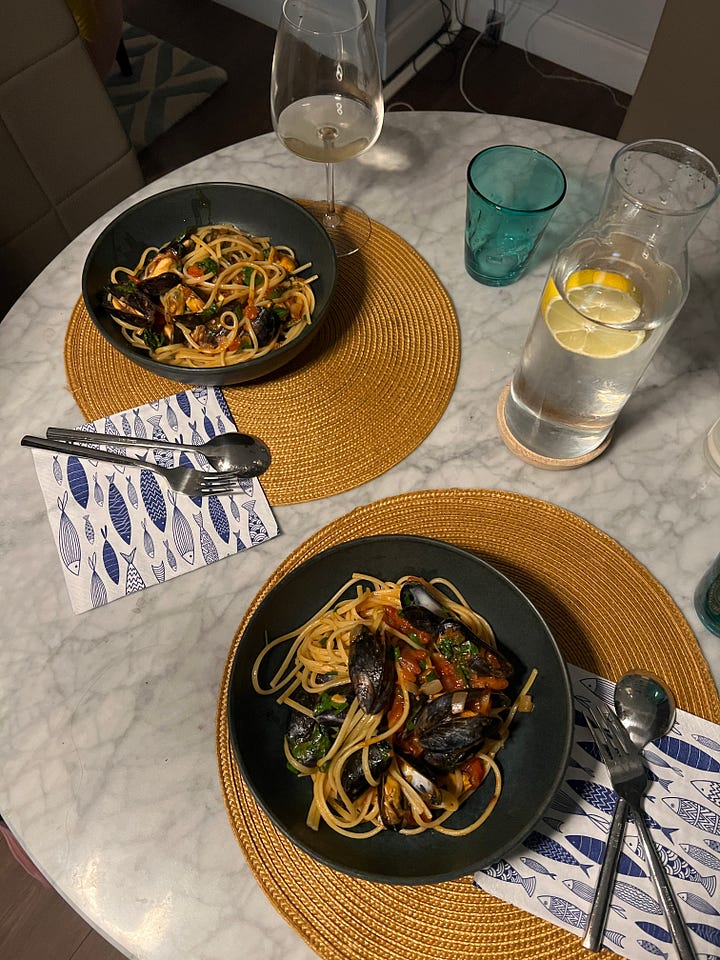
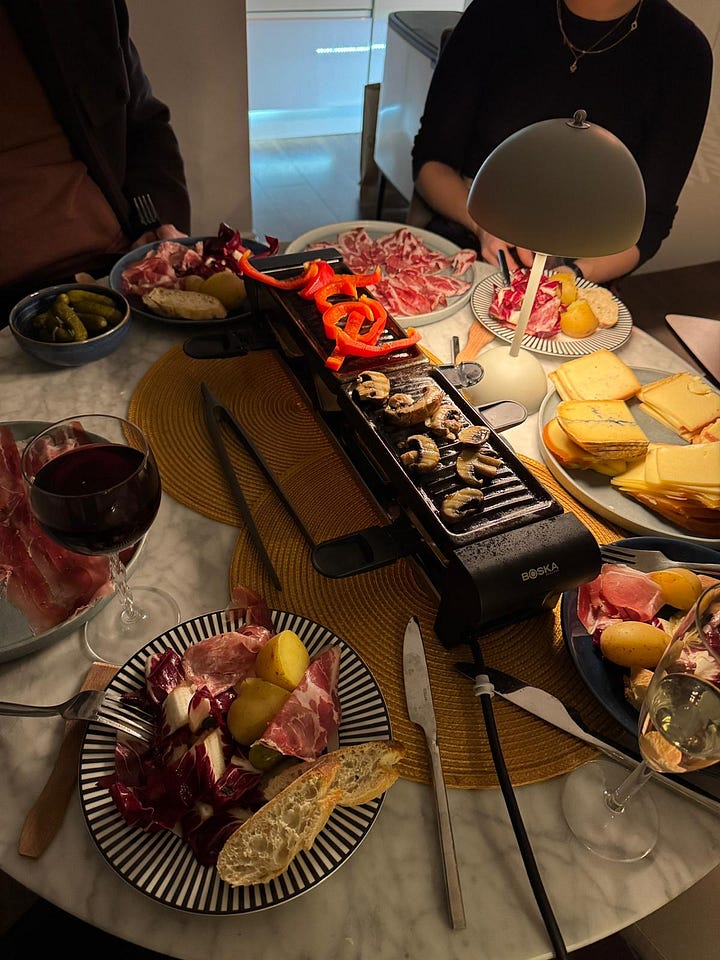
Another decision was to buy my tableware in threes. Given that I mostly socialise in groups of two or three in the flat, this is almost always enough. Previously, I owned an M&S dinner set for eight – which sent a strange signal to myself, every time I opened my cupboard, that I should really be hosting a huge extended family, rather than eating my evening meal alone.
I used to think this stuff was shallow. That it’s the people who dictate the quality of the connection; the rest is just backdrop. While I still believe the former is most important, the latter provides a framework. A supportive vessel for the really good stuff: a cosy night in with a novel, a candlelit dinner with company.
Finding the in-between
And then there’s the in-between: reading at opposite ends of the sofa, or a park bench, or around a dinner table – existing peacefully with someone, alone together, safe and content to be in your own head around them.
It’s been over half a decade since I first starting writing about alonement – the word I coined to describe quality time spent alone. For as long as I’ve been writing about this subject, I’ve butted up against a preconception that you have to favour one state, over the other. That you’re a loner, or a people-person. That you’re an introvert, or an extrovert – labels I have found less and less helpful as time goes on.
Alone time and socialising are both essential for us to thrive, as research demonstrates. The best spaces are ones that don’t make you choose one or the other. Which offer the opportunity for both, sometimes simultaneously. Now, where can I buy a hammock?
Watching…
Awards season is one of the best consolations of winter – which might explain why I’ve been to the cinema three times in the past week. My favourite visit was to see A Real Pain, directed, written by and starring Jesse Eisenberg, alongside Kieran Culkin (who has already won a Golden Globe for his role). It’s being described as a Holocaust movie, elsewhere as a buddy road trip movie – I personally don’t think either quite fits, and that it’s more about a complex family dynamic if anything. It’s one of those films that could be a play - a really good play – for the quality of its dialogue. It’s also only around 90 minutes, which I appreciated (do you hear that, Tarantino?!). I’m also very excited to see the Bob Dylan biopic at the end of this week.
Until next week!
Francesca


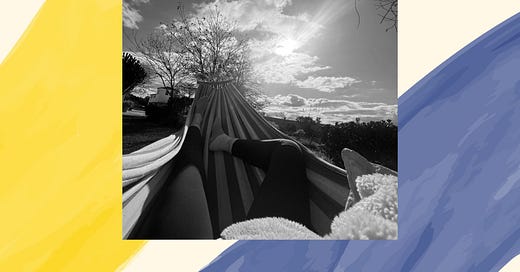



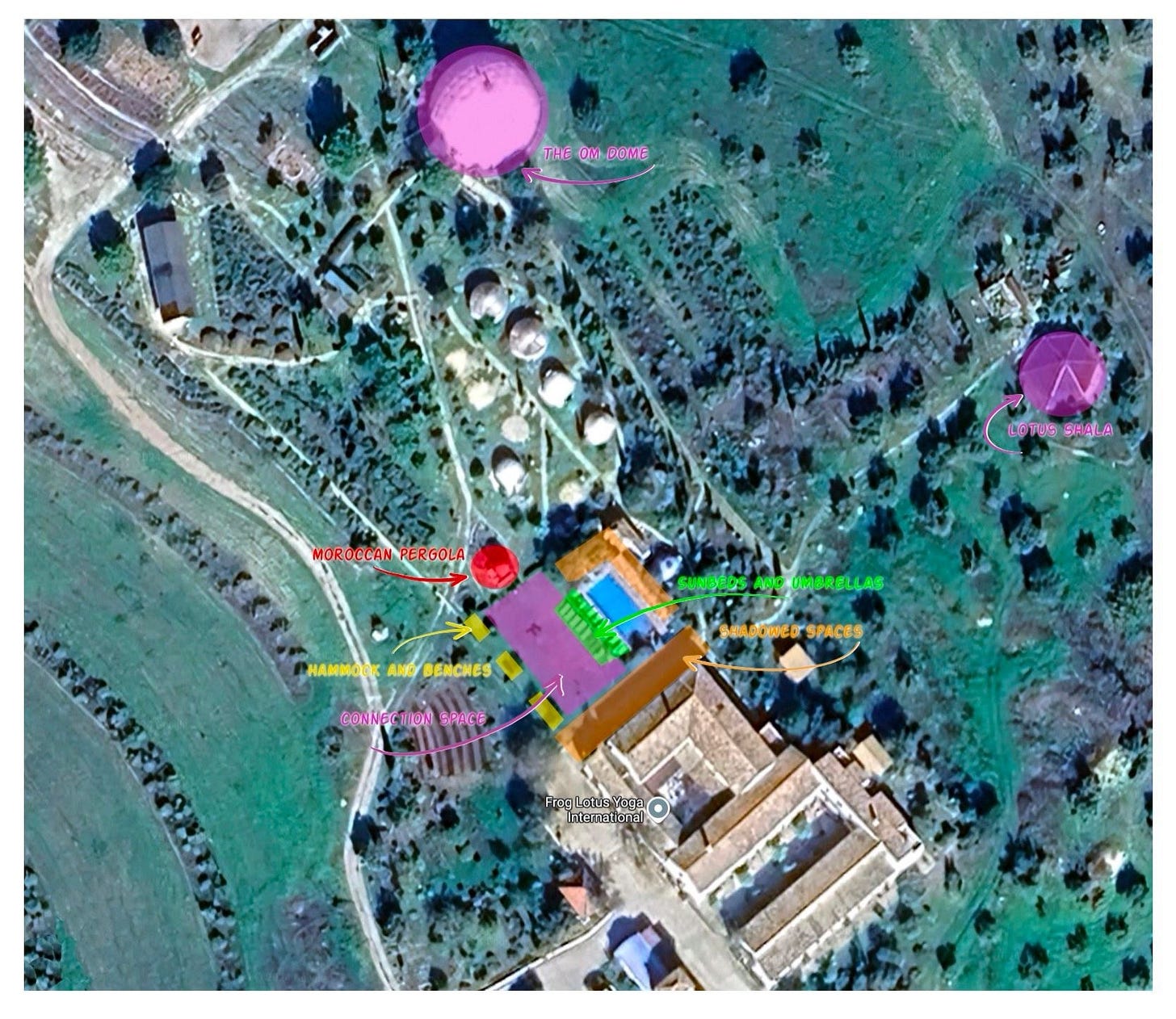




I thought this post was packed with so much to ponder about, both for those of us living alone but also those who want to be able to be alone with others. 😘
Can you tell me where you get your hammock from when you find one, although not sure my rickety bones and short stumpy legs could climb aboard 🤣🤣
Really interesting discussion.
I've really struggled with being alone. For various reasons I've spent most of my adult life alone. With other people but many hours on my own.
I've always found being still and alone with others in the same space so frustrating. I feel ignored. As if I'm just another inanimate object. And its been very hard. The more I try to interact the more they pull away. The aloness screams at me.
Now I'm not in an intimate partnership anymore. I live close to family. I don't spend so many hours alone. I still feel uncomfortable sharing quiet still space with others. Now I just move away to my own room. Being alone with myself is a much better option for me now.